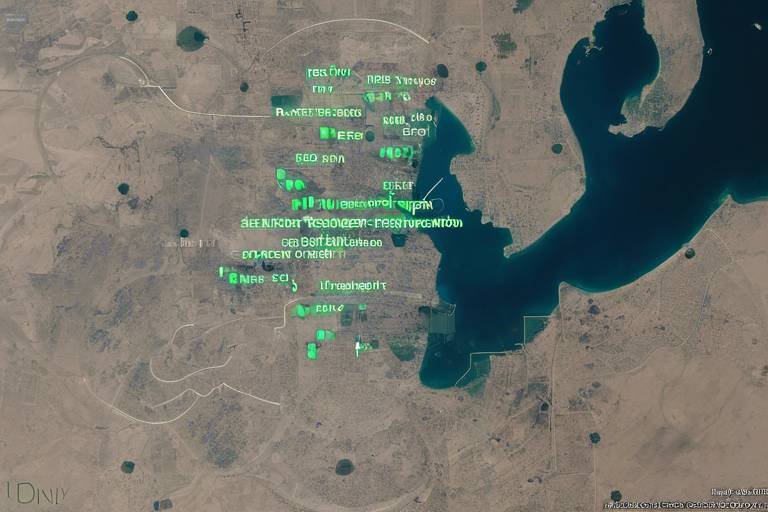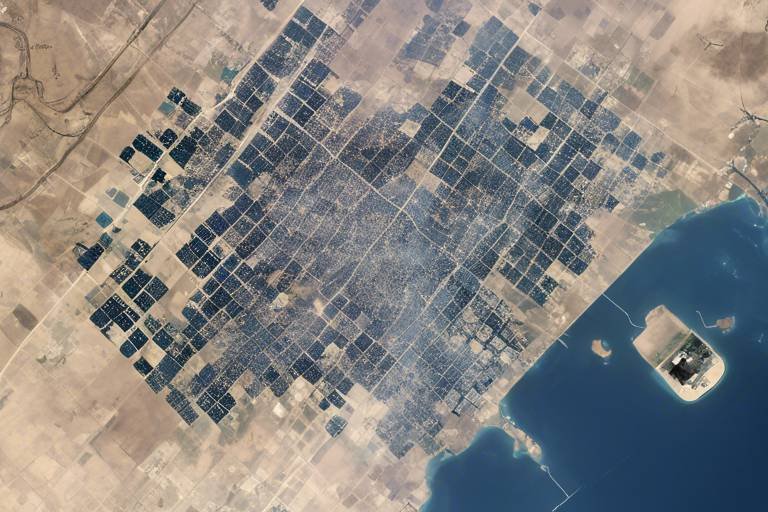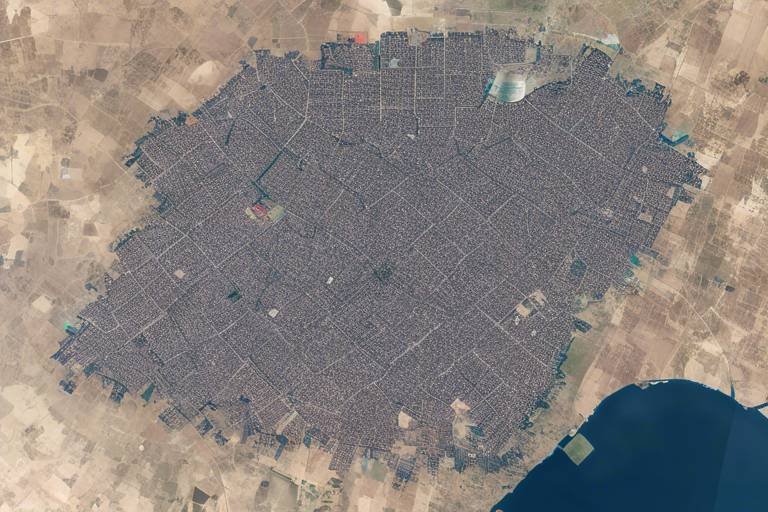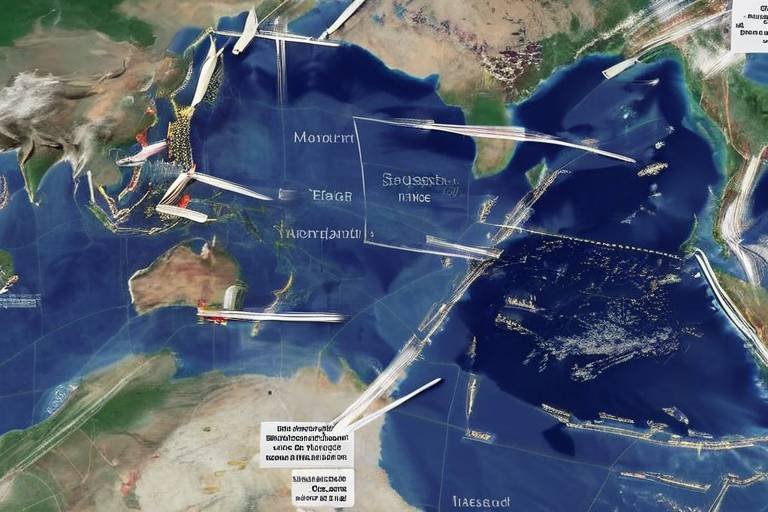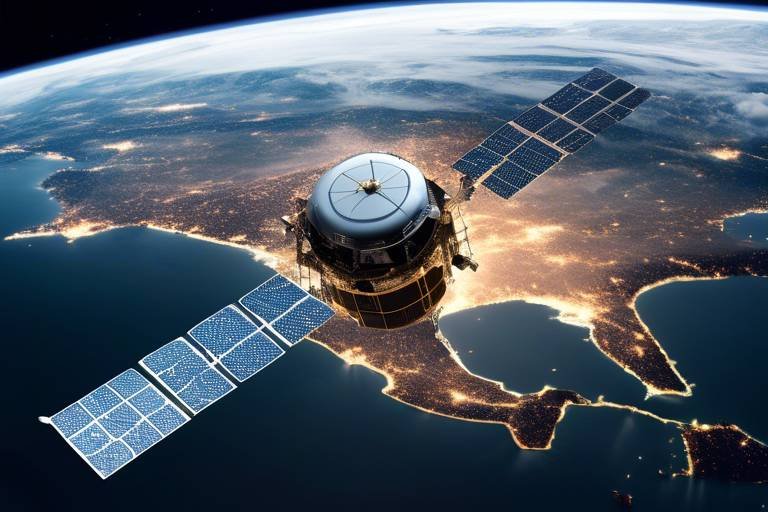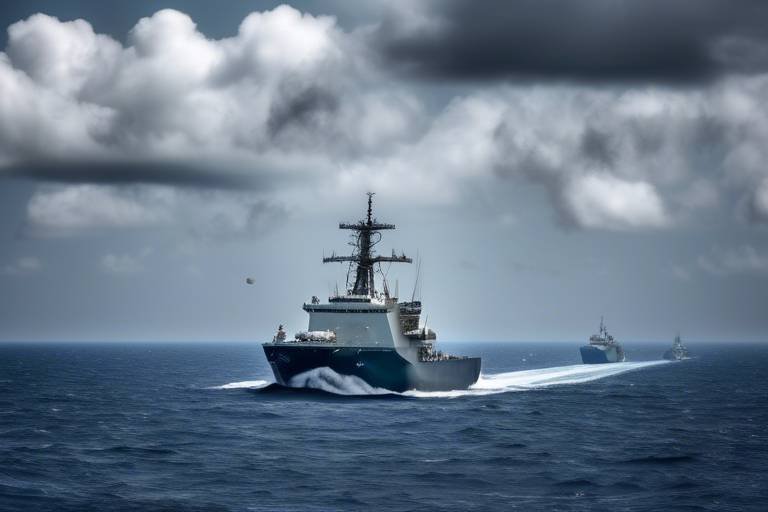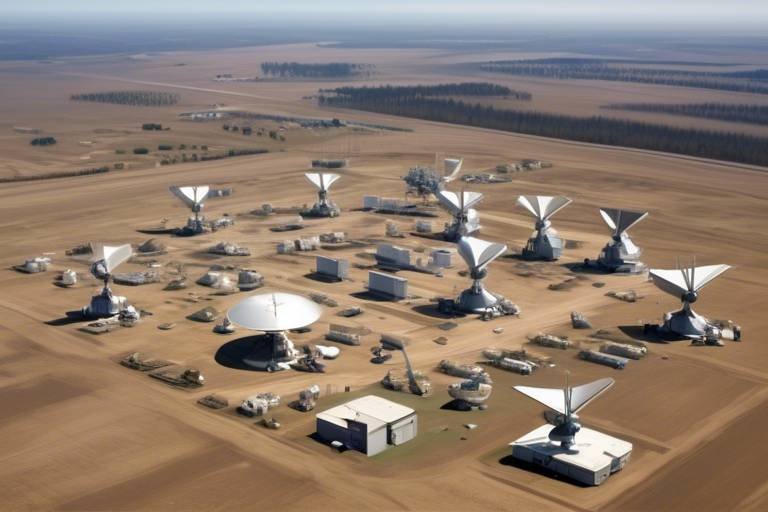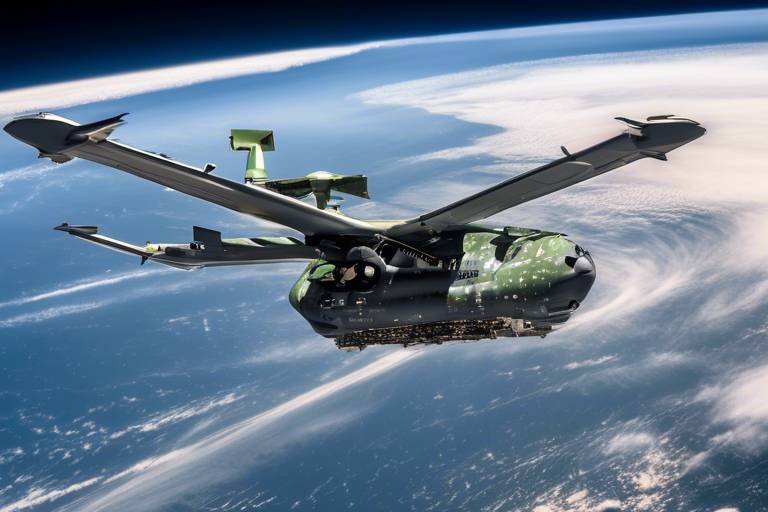How Satellites Improve Command and Control in Warfare
In the ever-evolving landscape of modern warfare, satellites have emerged as game-changers, revolutionizing the way military operations are conducted. Gone are the days when commanders relied solely on ground reports and outdated communication methods. Today, the integration of satellite technology into military strategy has transformed command and control capabilities, enabling forces to operate with unprecedented efficiency and coordination. Imagine a chess game where every piece can communicate instantaneously with the player; this is the essence of how satellites enhance military operations.
At the heart of this transformation lies the ability to facilitate real-time data exchange. Communication satellites serve as the backbone of military operations, allowing leaders to receive and transmit critical information at lightning speed. This capability is not just about speed; it's about making informed decisions swiftly, which can often mean the difference between victory and defeat on the battlefield. With satellite communications, commanders can coordinate complex maneuvers, share intelligence, and issue commands without delay, ensuring that every unit is synchronized and aware of the evolving situation.
Furthermore, the operational efficiency provided by satellites extends beyond mere communication. They enable a level of situational awareness that was previously unimaginable. Imagine being able to see the entire battlefield from above, with the ability to zoom in on specific areas of interest. This is precisely what satellite technology offers, allowing military leaders to assess threats, identify opportunities, and adjust strategies in real-time. The result is a more agile and responsive military force, capable of adapting to the dynamics of modern warfare.
However, the benefits of satellite technology in warfare are not limited to communication and coordination. The realm of surveillance and reconnaissance has also been significantly enhanced. Satellites provide vital data that shapes strategic planning and battlefield tactics. High-resolution imagery from satellites allows military intelligence to gather information on enemy positions and movements, providing a comprehensive view of the operational landscape.
Communication satellites are pivotal in ensuring that every piece of information reaches its destination without delay. They allow for seamless communication between ground troops, air support, and command centers. This interconnectedness is crucial, especially during fast-paced operations where every second counts. In fact, studies have shown that units equipped with satellite communication tools can respond to threats up to 30% faster than those relying on traditional methods.
Satellites play a critical role in modern surveillance and reconnaissance operations. With the ability to capture high-resolution images and collect data continuously, they provide military leaders with an extensive overview of the battlefield. This capability enhances strategic planning and allows for more effective battlefield tactics. For instance, the integration of satellite imagery into military operations has led to a significant increase in mission success rates.
High-resolution satellite imagery is a cornerstone of modern intelligence gathering. It enables military forces to identify enemy positions, track movements, and assess potential threats from a safe distance. This capability is akin to having a detailed map of the enemy’s territory, allowing for better-informed decisions. The accuracy of this imagery can be the deciding factor in planning successful operations, making it an invaluable asset in the arsenal of modern warfare.
Real-time satellite monitoring enhances the ability to track changes on the battlefield. Imagine being able to observe troop movements or detect enemy activity as it happens. This level of continuous observation allows military leaders to make timely decisions that can alter the course of an operation. The benefits of this capability extend beyond immediate tactical advantages; they also contribute to long-term strategic planning.
Data fusion techniques from multiple satellite sources improve the accuracy of situational assessments. By integrating data from various satellites, military analysts can create a comprehensive picture of the battlefield. This enhanced operational effectiveness is crucial in a world where information is often fragmented and overwhelming. The ability to synthesize data into actionable intelligence is what sets successful military operations apart from those that falter.
Satellite navigation systems, such as GPS, are essential for precise troop movements. In a military context, accurate positioning can mean the difference between success and failure. Troops equipped with GPS can navigate unfamiliar terrain with confidence, ensuring they reach their objectives efficiently. This capability is particularly important in modern warfare, where rapid movement and adaptability are key to overcoming adversaries.
As the reliance on satellites grows, so do the cybersecurity threats associated with them. The vulnerabilities that satellites face can have serious implications for military operations. Understanding these threats is crucial for maintaining operational security and ensuring that communication lines remain intact.
Various risks threaten the integrity of satellite systems, including cyberattacks and physical threats. The potential for hostile entities to disrupt or destroy satellite systems poses a significant challenge for military operations. This reality underscores the importance of robust cybersecurity measures and continuous monitoring of satellite systems.
Effective countermeasures are necessary to safeguard satellite systems. Military organizations are investing in advanced technologies to protect against cyberattacks and physical threats. Strategies include enhancing encryption methods, developing redundant systems, and conducting regular security assessments. By implementing these measures, military forces can better secure their satellite communications and maintain operational effectiveness.
- How do satellites enhance communication in warfare? Satellites provide real-time data exchange, enabling swift decision-making and improved coordination among military forces.
- What role do surveillance satellites play? They offer comprehensive situational awareness through high-resolution imagery, allowing for effective strategic planning and battlefield tactics.
- Are satellites vulnerable to cyberattacks? Yes, as reliance on satellites increases, so do the cybersecurity threats they face, necessitating robust protective measures.
The Role of Communication Satellites
Communication satellites are the unsung heroes of modern warfare, acting as the backbone of military operations by facilitating real-time data exchange. Imagine a battlefield where every second counts; commanders need to make split-second decisions that could mean the difference between victory and defeat. This is where communication satellites come into play, providing a seamless link between ground troops and command centers. By enabling swift communication, these satellites enhance operational efficiency and coordination among forces, allowing for a more agile response to evolving situations.
The impact of communication satellites on military strategy cannot be overstated. They ensure that vital information flows freely and quickly, which is essential for maintaining situational awareness. For instance, during a military operation, commanders can relay instructions to troops in real-time, receive updates on enemy movements, and adjust strategies accordingly. This level of connectivity is comparable to a conductor leading an orchestra; without clear communication, the performance can quickly devolve into chaos.
One of the most significant advantages of communication satellites is their ability to cover vast areas. Unlike traditional communication methods, which may be limited by geography or infrastructure, satellites can reach remote locations where ground-based communication systems might fail. This capability is particularly crucial in conflict zones where infrastructure may be damaged or non-existent. The following table illustrates some of the key benefits of communication satellites in warfare:
| Benefit | Description |
|---|---|
| Global Coverage | Satellites can provide communication links over large geographical areas, ensuring connectivity in remote locations. |
| Real-Time Data Exchange | Enables instant communication between command centers and troops, facilitating quick decision-making. |
| Enhanced Coordination | Improves collaboration among different military branches, leading to more effective operations. |
| Resilience | Less susceptible to physical attacks compared to ground-based communication systems. |
Furthermore, the integration of advanced technologies such as secure communication protocols and encryption ensures that sensitive military information remains protected from adversaries. This is particularly important in an age where cyber warfare is becoming increasingly prevalent. By utilizing communication satellites, military forces can maintain a tactical advantage, ensuring that their plans and movements remain confidential.
In conclusion, communication satellites are not just tools; they are essential components of modern military operations. By providing a reliable and secure means of communication, they empower military leaders to make informed decisions swiftly. As warfare continues to evolve, the role of these satellites will undoubtedly become even more critical, shaping the future of command and control on the battlefield.
Surveillance and Reconnaissance Capabilities
In the ever-evolving landscape of modern warfare, the importance of surveillance and reconnaissance cannot be overstated. Satellites have emerged as critical assets, providing military forces with the ability to gather intelligence from vast distances. Imagine being able to observe an entire battlefield from space, pinpointing enemy locations and movements with incredible precision. This capability not only enhances situational awareness but also shapes strategic planning and battlefield tactics in ways that were previously unimaginable.
Satellites equipped with advanced sensors and imaging technology enable military leaders to maintain a constant watch over potential conflict zones. This continuous observation is vital for understanding the dynamics of the battlefield. For instance, high-resolution satellite imagery can reveal troop concentrations, supply routes, and even the construction of defensive positions. Such detailed insights allow commanders to make informed decisions, ultimately leading to more effective operations.
One of the most significant contributions of satellites to military intelligence is imagery intelligence. This involves the collection and analysis of images captured by satellites, which can provide a wealth of information about enemy activities. High-resolution imagery can identify specific vehicles, equipment, and even the presence of personnel in designated areas. This intelligence is crucial for planning strikes, conducting reconnaissance missions, and assessing the effectiveness of previous operations.
The ability to monitor developments in real-time transforms the battlefield landscape. With the help of satellites, military forces can track changes in enemy positions as they happen. This capability allows for rapid response to emerging threats and the adjustment of tactics on the fly. Imagine a scenario where a commander can see enemy reinforcements arriving and can reroute their own forces to counteract this move before it becomes a serious threat. This level of responsiveness can turn the tide of battle.
Another significant advancement in satellite surveillance is the use of data fusion techniques. By integrating data from multiple satellite sources, military analysts can create a comprehensive picture of the battlefield. This approach enhances the accuracy of situational assessments, as it combines various data types—such as imagery, signals intelligence, and environmental data—into a cohesive analysis. This not only improves decision-making but also helps in predicting enemy actions based on observed patterns.
The synergy between different satellite systems can be likened to a symphony orchestra, where each instrument contributes to a harmonious performance. In this case, each satellite provides unique data that, when combined, offers a more complete understanding of the operational environment. This level of detail is crucial for commanders who need to anticipate the enemy's next move and plan accordingly.
In conclusion, the role of satellites in surveillance and reconnaissance capabilities is indispensable in modern warfare. Their ability to provide real-time data, high-resolution imagery, and integrated intelligence not only enhances operational effectiveness but also ensures that military leaders can make timely and informed decisions. As technology continues to advance, the impact of satellite surveillance will only grow, further revolutionizing the way military operations are conducted.
- How do satellites contribute to military intelligence?
Satellites provide high-resolution imagery and real-time data that help military leaders make informed decisions regarding troop movements and strategy. - What is imagery intelligence?
Imagery intelligence involves the analysis of satellite images to gather information about enemy positions and activities. - How does data fusion improve military operations?
Data fusion combines information from multiple satellite sources, enhancing accuracy and providing a comprehensive view of the battlefield.
Imagery Intelligence
is a game-changer in the realm of modern warfare, providing military leaders with a bird's-eye view of the battlefield. Imagine having the ability to see enemy positions, troop movements, and even the layout of their defenses—all from the comfort of a command center thousands of miles away. This is the power that high-resolution satellite imagery brings to the table. With the advancement of technology, satellites equipped with sophisticated imaging systems can capture detailed images that are crucial for making strategic decisions.
One of the primary advantages of imagery intelligence is its ability to deliver real-time data. In fast-paced military operations, every second counts. The quicker commanders can access accurate information, the better their chances of outmaneuvering the enemy. For instance, during an operation, if a commander can see that enemy reinforcements are approaching a critical location, they can make a swift decision to reposition their forces or launch a preemptive strike. This immediacy transforms the battlefield into a dynamic environment where information is power.
Furthermore, high-resolution imagery can be processed and analyzed to reveal patterns and trends. For example, by examining satellite images over time, analysts can identify changes in enemy activity, such as the construction of new facilities or the movement of troops. This kind of analysis is akin to piecing together a puzzle—each image adds a new piece, helping to form a clearer picture of the enemy's capabilities and intentions.
To illustrate the impact of imagery intelligence, consider the following table that highlights some key applications:
| Application | Description | Benefits |
|---|---|---|
| Target Identification | Locating and identifying enemy assets. | Increases accuracy in targeting, reducing collateral damage. |
| Battlefield Assessment | Evaluating the terrain and enemy positions. | Enhances strategic planning and troop deployment. |
| Change Detection | Monitoring changes in the battlefield environment. | Enables timely responses to enemy movements. |
In addition to these applications, imagery intelligence also plays a vital role in counterinsurgency operations. By providing insights into civilian movements and potential insurgent hideouts, military forces can operate more effectively without alienating local populations. This delicate balance is essential for winning hearts and minds in conflict zones.
However, it's important to recognize that while imagery intelligence is incredibly powerful, it is not without its challenges. The sheer volume of data generated can be overwhelming, requiring advanced analytics and skilled personnel to sift through and interpret the information. Moreover, adversaries are becoming increasingly adept at countering these technologies, employing tactics such as camouflage and decoys to mislead satellite imagery.
In conclusion, imagery intelligence is a cornerstone of modern military operations, providing critical insights that can shape the outcome of conflicts. As technology continues to evolve, the potential for satellite imagery to enhance situational awareness and operational effectiveness will only grow, proving that in the world of warfare, knowledge truly is power.
- What is imagery intelligence?
Imagery intelligence refers to the analysis and interpretation of satellite images to gather information about enemy positions, movements, and other critical battlefield data.
- How does satellite imagery improve military operations?
It provides real-time data, enhances situational awareness, and aids in strategic planning, allowing military leaders to make informed decisions quickly.
- What are the challenges associated with imagery intelligence?
The challenges include data overload, the need for advanced analytics, and the increasing sophistication of enemy countermeasures.
Real-Time Monitoring
In the fast-paced world of warfare, the ability to monitor the battlefield in real-time is nothing short of revolutionary. Imagine a chess game where you can see your opponent's every move before they make it. This is exactly what real-time satellite monitoring offers military commanders. By providing up-to-the-minute updates on troop movements, weather conditions, and enemy positions, satellites act as the eyes in the sky, ensuring that decisions are based on the most current information available.
Real-time monitoring not only enhances situational awareness but also significantly improves response times. When a commander receives immediate data about an enemy's actions, they can adjust their strategies on the fly, deploying forces where they are needed most. This agility can mean the difference between victory and defeat, making real-time satellite monitoring an invaluable asset on the modern battlefield.
Moreover, the integration of various technologies enhances the effectiveness of real-time monitoring. For instance, satellites equipped with advanced sensors can detect changes in the environment, such as the movement of vehicles or the buildup of troops. This data can be fused with other intelligence sources, creating a comprehensive picture of the battlefield. The following table illustrates the key components of real-time monitoring:
| Component | Description | Benefits |
|---|---|---|
| Satellite Sensors | Advanced sensors collect data on ground movements. | Provides accurate, real-time updates on enemy positions. |
| Data Fusion | Combines information from multiple sources. | Enhances situational awareness and decision-making. |
| Communication Systems | Facilitates the transmission of data to command centers. | Ensures timely access to critical information. |
Additionally, the use of real-time monitoring systems helps in assessing the effectiveness of military operations. By continuously tracking the impact of tactical decisions, military leaders can refine their strategies, learning what works and what doesn’t in real-time. This iterative process is akin to a sports coach analyzing plays while the game is still in progress, allowing for quick adjustments that can lead to better outcomes.
In conclusion, real-time satellite monitoring is not just a technological advancement; it is a game-changer in warfare. By providing critical information at lightning speed, it empowers military leaders to act decisively and strategically, ultimately enhancing the effectiveness of military operations.
- What is real-time monitoring in military operations?
Real-time monitoring refers to the continuous observation and data collection from satellites, providing immediate updates on battlefield conditions and enemy movements. - How does satellite monitoring improve decision-making?
It allows commanders to receive current information, enabling them to make timely and informed decisions that can adapt to changing battlefield dynamics. - What technologies are involved in real-time monitoring?
Technologies include satellite sensors, communication systems, and data fusion techniques that integrate information from various sources.
Data Fusion Techniques
In the realm of modern warfare, are revolutionizing how military forces assess and respond to dynamic battlefield environments. Imagine a conductor leading an orchestra, where each instrument represents a different source of information. Just as the conductor harmonizes these sounds to create a beautiful symphony, data fusion integrates diverse data streams to provide a coherent picture of the operational landscape. This process enhances situational awareness, allowing commanders to make decisions that are not just informed but also timely and precise.
At the heart of data fusion is the ability to combine information from multiple satellite sources, each offering unique insights. For instance, one satellite may provide high-resolution imagery, while another might deliver real-time weather data. By merging these datasets, military analysts can develop a comprehensive understanding of enemy movements, terrain conditions, and even potential threats. This multidimensional approach to data analysis is akin to piecing together a complex puzzle; every piece matters, and when combined, they reveal a clearer picture of the battlefield.
Moreover, the integration of artificial intelligence (AI) and machine learning into data fusion processes is a game-changer. These technologies can sift through vast amounts of data at lightning speed, identifying patterns and anomalies that human analysts might miss. For example, AI algorithms can analyze satellite images to detect changes in enemy fortifications or troop deployments, providing military leaders with actionable intelligence in real time. This capability not only enhances operational effectiveness but also minimizes the risk of human error, which can have catastrophic consequences in a combat scenario.
To illustrate the benefits of data fusion techniques, consider the following table that outlines the key components and advantages of this approach:
| Component | Description | Advantages |
|---|---|---|
| Multi-source Integration | Combining data from various satellite systems | Provides a holistic view of the battlefield |
| Real-time Analysis | Continuous processing of incoming data | Enables quick decision-making |
| AI and Machine Learning | Automated pattern recognition and anomaly detection | Reduces human error and enhances accuracy |
| Enhanced Situational Awareness | Comprehensive understanding of the operational environment | Improves strategic planning and execution |
In conclusion, data fusion techniques are not just about gathering information; they are about transforming that information into a strategic asset. As military operations become increasingly complex, the ability to synthesize various data sources into actionable intelligence will be paramount. This technological evolution is paving the way for a new era of warfare, where information superiority can mean the difference between victory and defeat.
- What is data fusion in military operations? Data fusion refers to the process of integrating data from multiple sources to create a comprehensive picture of the operational environment, enhancing situational awareness and decision-making.
- How do AI and machine learning play a role in data fusion? AI and machine learning enable the automated analysis of large datasets, allowing for quicker identification of patterns and anomalies that inform military strategies.
- Why is real-time data important in warfare? Real-time data allows military leaders to respond swiftly to changing conditions on the battlefield, ensuring that decisions are based on the most current information available.
- What are the advantages of using multiple satellite sources? Using multiple satellite sources provides a more detailed and accurate understanding of the battlefield, as different satellites can offer unique insights, such as imagery, weather data, and communications.
Navigation and Positioning
In the chaotic theatre of modern warfare, precise navigation and positioning are not just advantageous; they are absolutely essential. The advent of satellite navigation systems, particularly the Global Positioning System (GPS), has revolutionized how military operations are conducted. Imagine trying to navigate through a dense forest or an urban battlefield without a reliable map or a clear sense of direction. This is where satellites come into play, acting like a guiding star in the night sky, ensuring that troops can find their way with pinpoint accuracy.
GPS technology allows military units to determine their exact location within a few meters, which is crucial for coordinating movements and executing complex maneuvers. This level of precision means that commanders can deploy forces more effectively, ensuring that troops are positioned optimally for both offensive and defensive operations. The ability to track the exact location of friendly units minimizes the risk of friendly fire incidents, a common concern in the heat of battle.
Moreover, satellite navigation systems provide critical data that enhances logistical operations. For instance, supply chains heavily rely on accurate positioning to ensure that supplies reach the right units at the right time. Without this technology, delays could lead to dire consequences, such as troops lacking essential resources during crucial moments. In essence, GPS serves as the backbone of military logistics, making it possible to maintain a steady flow of supplies and reinforcements.
Furthermore, the integration of satellite navigation into weapon systems has transformed how precision strikes are conducted. Today, many smart munitions rely on GPS coordinates to hit their targets with incredible accuracy. This capability reduces collateral damage and increases the effectiveness of military operations. Imagine a laser-guided bomb striking a target with surgical precision, all thanks to satellite positioning. This level of accuracy not only saves lives but also enhances operational success.
However, as we embrace the benefits of satellite navigation, it is crucial to acknowledge the vulnerabilities associated with it. The reliance on GPS makes military operations susceptible to jamming and spoofing attacks, where adversaries can disrupt or deceive navigation signals. To counter these threats, militaries worldwide are investing in alternative navigation systems, such as inertial navigation and even emerging technologies like quantum positioning systems, which promise to provide reliable navigation without the need for external signals.
In conclusion, satellite navigation and positioning are vital components of modern warfare that enhance operational effectiveness and troop safety. The ability to navigate with precision allows military forces to execute complex strategies, coordinate logistics seamlessly, and conduct precision strikes. As technology evolves, the military must remain vigilant against potential threats to these systems while continuing to leverage their advantages.
- How does GPS work in military operations? GPS provides real-time location data, allowing for precise navigation and coordination of troop movements.
- What are the risks associated with satellite navigation? Risks include jamming and spoofing attacks that can disrupt or mislead navigation signals.
- Are there alternatives to GPS for military navigation? Yes, militaries are exploring inertial navigation systems and quantum positioning technologies as alternatives.
- How has satellite navigation changed warfare? It has enhanced operational efficiency, reduced friendly fire incidents, and improved logistics and precision strikes.
Cybersecurity Challenges
As we embrace the technological marvels that satellites bring to modern warfare, we must also confront the that accompany their use. The reliance on satellite systems for communication, navigation, and surveillance makes them prime targets for cyberattacks. Imagine a battlefield where the very tools designed to provide an advantage become liabilities due to malicious interference. This scenario is not just a possibility; it is a growing concern for military strategists around the globe.
One of the most pressing issues is the vulnerability of satellite communication links. These links, which facilitate critical data exchange between ground forces and command centers, can be intercepted or jammed by adversaries. The implications of such attacks are profound. Without secure communication, military leaders may struggle to coordinate operations or respond to dynamic battlefield conditions. This is akin to trying to steer a ship in a storm without a compass; every decision becomes fraught with uncertainty.
To illustrate the gravity of these threats, consider the following table which outlines some of the primary cybersecurity risks faced by satellite systems:
| Type of Threat | Description | Potential Impact |
|---|---|---|
| Signal Interception | Unauthorized access to satellite communications. | Loss of sensitive information, compromised operations. |
| Signal Jamming | Deliberate disruption of satellite signals. | Communication breakdown, operational chaos. |
| Hacking | Unauthorized intrusion into satellite control systems. | Manipulation of satellite functions, data corruption. |
| Physical Attacks | Direct attacks on satellite infrastructure. | Destruction of satellites, loss of capabilities. |
In addition to these threats, the rapid advancement of technology means that cyber adversaries are becoming increasingly sophisticated. They employ various tactics, such as phishing and malware, to exploit vulnerabilities in satellite systems. This arms race between military technology and cyber threats is reminiscent of the Cold War, where each side constantly sought to outdo the other in capabilities and defenses.
To combat these challenges, military organizations are investing heavily in cybersecurity measures. This includes the development of robust encryption protocols to protect satellite communications, as well as the implementation of advanced intrusion detection systems that can identify and neutralize threats in real-time. Training personnel to recognize and respond to potential cyber threats is equally crucial. Just as a soldier must be trained to navigate the complexities of the battlefield, cybersecurity professionals must be equipped to handle the intricate landscape of digital warfare.
Moreover, collaboration with private sector tech firms is becoming increasingly vital. These companies often have cutting-edge technologies and expertise that can enhance military cybersecurity efforts. By working together, the military and the private sector can create a formidable defense against potential cyberattacks. In essence, it's a partnership where both parties can learn from each other, much like a seasoned general sharing wisdom with a young recruit.
In conclusion, as we continue to integrate satellites into military operations, addressing cybersecurity challenges must be a top priority. The stakes are high, and the consequences of inaction could be disastrous. Just as a fortress needs strong walls to protect its inhabitants, military satellite systems require robust cybersecurity measures to ensure their effectiveness in warfare.
- What are the main cybersecurity threats to satellites?
The primary threats include signal interception, jamming, hacking, and physical attacks on satellite infrastructure. - How can military organizations protect their satellite systems?
They can implement strong encryption protocols, intrusion detection systems, and collaborate with private tech firms for enhanced security. - Why is satellite cybersecurity important in modern warfare?
Secure satellite communications are crucial for operational coordination and decision-making on the battlefield.
Threats to Satellite Integrity
The integrity of satellites is paramount in maintaining effective command and control during military operations. However, as the reliance on these orbiting sentinels increases, so does the range of threats they face. These threats can be categorized into several key areas, including cybersecurity vulnerabilities, physical attacks, and space debris, each posing unique challenges to satellite functionality.
First and foremost, the cybersecurity vulnerabilities of satellites cannot be overstated. With the military's increasing dependence on satellite communications, hackers and hostile nations are constantly seeking ways to infiltrate these systems. Cyberattacks can disrupt communications or even take control of satellite operations, leading to potentially catastrophic consequences. For instance, if an adversary successfully hacks into a satellite's control system, they could manipulate its functions, rendering it useless or even turning it against its own operators.
Moreover, physical attacks on satellites present another significant threat. While it may sound like a plot from a sci-fi movie, the reality is that anti-satellite weapons (ASAT) are being developed and tested by various nations. These weapons can target and destroy satellites in orbit, thereby crippling a military's ability to gather intelligence or communicate effectively. The potential for conflict in space raises serious concerns about the safety and security of satellite systems.
In addition to cyber and physical threats, space debris poses a growing risk to satellite integrity. As more satellites are launched into orbit, the amount of debris increases, creating a hazardous environment for operational satellites. Collisions with even small pieces of debris can result in significant damage, potentially leading to the loss of critical communication or surveillance capabilities. The unpredictability of space debris makes it a challenge for military planners to ensure the longevity and functionality of their satellite systems.
To effectively address these threats, military organizations must adopt a multi-faceted approach that includes:
- Strengthening cybersecurity measures: Implementing advanced encryption and security protocols can help safeguard satellite communications from cyber threats.
- Developing countermeasures: Investing in technologies that can detect and neutralize potential physical threats, including ASAT weapons, is crucial.
- Monitoring space debris: Continuous tracking and predictive modeling of space debris can help in planning satellite maneuvers to avoid potential collisions.
In conclusion, the threats to satellite integrity are complex and multifaceted, requiring constant vigilance and innovation. As military operations increasingly rely on these critical assets, understanding and mitigating these threats will be essential for maintaining operational superiority in an ever-evolving battlefield.
- What are the main threats to satellite integrity? The main threats include cybersecurity vulnerabilities, physical attacks from anti-satellite weapons, and collisions with space debris.
- How can military organizations protect their satellites? They can enhance cybersecurity, develop countermeasures against physical threats, and monitor space debris effectively.
- Why is satellite integrity important for military operations? Satellite integrity is crucial for maintaining communication, surveillance, and navigation capabilities, which are essential for effective command and control.
Countermeasures and Defense Strategies
In the ever-evolving landscape of modern warfare, the security of satellite systems is paramount. As military operations increasingly rely on satellites for communication, navigation, and surveillance, it becomes essential to implement robust countermeasures and defense strategies to protect these assets. The threats to satellites can come from various sources, including cyberattacks, physical attacks, and even natural phenomena. Therefore, understanding these risks and employing effective countermeasures is critical to maintaining operational integrity.
One of the primary strategies to safeguard satellites is the implementation of encryption techniques for data transmission. By encrypting the data sent between satellites and ground stations, militaries can significantly reduce the risk of interception and unauthorized access. This is akin to locking your front door; it adds an essential layer of security that deters potential intruders. Moreover, employing advanced firewalls and intrusion detection systems can help in identifying and mitigating cyber threats before they escalate into serious breaches.
In addition to cybersecurity measures, physical security is also crucial. This involves protecting ground stations and satellite launch facilities from potential physical attacks. Military installations often employ armed security forces, surveillance cameras, and access control systems to monitor and protect these sensitive areas. Furthermore, the use of redundant systems can ensure that if one satellite is compromised, others can take over its functions, thereby maintaining operational capabilities.
Another innovative approach is the development of anti-jamming technologies. Jamming is a tactic used by adversaries to disrupt satellite communications. By using frequency-hopping spread spectrum technology, military satellites can change frequencies rapidly, making it difficult for jammers to effectively disrupt signals. This technology acts like a magician’s trick, keeping the enemy guessing and unable to pinpoint the satellite’s location.
Moreover, collaborative defense strategies among allied nations can enhance satellite security. By sharing intelligence and resources, countries can create a more resilient satellite network. This collaboration is similar to a neighborhood watch program, where communities come together to protect their homes. Joint exercises and training programs can also help military personnel stay ahead of potential threats, ensuring they are well-prepared to respond to any incidents that may arise.
As we look to the future, the importance of artificial intelligence (AI) in satellite defense cannot be overlooked. AI can analyze vast amounts of data to detect anomalies and potential threats in real-time. This capability allows for quicker responses to emerging threats, enhancing the overall resilience of satellite systems. Just like having a vigilant guard dog that alerts you to intruders, AI can serve as an early warning system, providing critical information before a situation escalates.
In summary, the countermeasures and defense strategies employed to protect satellites are multifaceted and require a comprehensive approach. From encryption and physical security to collaborative efforts and the use of AI, each element plays a vital role in ensuring the integrity and reliability of military satellite operations. As threats continue to evolve, so too must our strategies, ensuring that we remain one step ahead in the ever-competitive realm of modern warfare.
- What are the main threats to military satellites? Military satellites face threats from cyberattacks, physical attacks, and natural phenomena.
- How does encryption protect satellite communications? Encryption secures data transmissions, making it difficult for unauthorized parties to intercept or access sensitive information.
- What role does AI play in satellite defense? AI can analyze data to detect anomalies and potential threats, allowing for quicker responses to emerging risks.
- Why is physical security important for satellite systems? Protecting ground stations and launch facilities from physical attacks ensures the operational integrity of satellite systems.
Frequently Asked Questions
- How do communication satellites enhance military operations?
Communication satellites enable real-time data exchange, allowing military leaders to make swift, informed decisions. This capability enhances operational efficiency and coordination among various military forces, ensuring everyone is on the same page during critical missions.
- What is the significance of surveillance and reconnaissance capabilities provided by satellites?
Satellites play a pivotal role in providing comprehensive situational awareness through vital surveillance and reconnaissance data. This information shapes strategic planning and battlefield tactics, allowing commanders to anticipate enemy movements and adapt their strategies accordingly.
- How does imagery intelligence from satellites aid in military operations?
High-resolution satellite imagery is essential for intelligence gathering, helping military forces identify enemy positions and movements. This type of intelligence allows for better planning and execution of operations, ultimately improving the chances of success on the battlefield.
- What are the benefits of real-time satellite monitoring?
Real-time satellite monitoring enhances the ability to track changes on the battlefield continuously. This capability is crucial for timely decision-making, enabling military leaders to respond quickly to evolving situations and maintain an advantage over adversaries.
- How do data fusion techniques improve operational effectiveness?
Data fusion techniques integrate information from multiple satellite sources, improving the accuracy of situational assessments. By combining data, military forces can gain a more comprehensive understanding of the battlefield, leading to better strategic decisions and enhanced operational effectiveness.
- Why are satellite navigation systems like GPS important in warfare?
Satellite navigation systems, such as GPS, are vital for precise troop movements and coordination. They allow military units to navigate accurately, ensuring that forces can reach their destinations efficiently and execute missions with minimal delays.
- What cybersecurity challenges do satellites face?
As reliance on satellites grows, so do cybersecurity threats. Satellites are vulnerable to various risks, including hacking and jamming, which can compromise critical military communications and operational security.
- What measures are taken to protect satellites from cyber threats?
To safeguard satellite systems, military organizations employ effective countermeasures and defense strategies. These may include advanced encryption, continuous monitoring for suspicious activity, and physical security measures to protect satellite infrastructure from potential attacks.
- What are the potential threats to satellite integrity?
Understanding potential threats to satellite integrity is crucial for maintaining operational security. Risks include cyberattacks, physical attacks on satellite infrastructure, and natural phenomena that can disrupt satellite functions.
- How do military forces adapt to the evolving landscape of satellite warfare?
Military forces continuously adapt to the evolving landscape of satellite warfare by investing in new technologies, enhancing cybersecurity measures, and developing strategies to counteract potential threats to satellite operations. This proactive approach ensures that they remain effective in modern combat scenarios.



